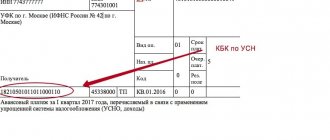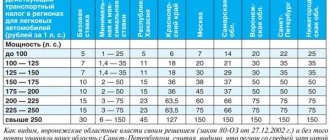Transport tax
In the taxation system of the Russian Federation, there are several types of taxes and fees, which can be divided into 3 hierarchical levels:
- Federal taxes are the main taxes of the country, which are regulated by the Tax Code of the Russian Federation. Fed. taxes are paid by all enterprises, individual entrepreneurs and individuals. persons regardless of their location (and residence). The rates of these taxes are established for all taxpayers who are residents of the Russian Federation, regardless of their organizational and legal status. Such taxes include, for example: VAT,
- personal income tax,
- state duties,
- license fees (excise taxes on alcohol, tobacco, cars, gasoline, etc.),
- income tax, etc.
- corporate property tax,
- personal property tax persons,
It should be noted that division by territorial affiliation does not affect either control or penalties of regulators, but provides for the distribution of budget funds only territorially.
In our case, the transport tax is a regional tax.
Deadlines for payment of advance payments for transport tax
TN is a regional tax, therefore some features of its payment are determined by the authorities of the constituent entities of the Russian Federation by the relevant law (Article 356 of the Tax Code of the Russian Federation). In particular, for taxpayers-organizations, the law of the subject establishes the procedure and deadlines for paying tax, including the presence/absence of an obligation and the deadlines (if an obligation is established) for making advance payments for transport tax.
For example, an advance payment system operates in the Moscow region. In accordance with paragraph 1 of Art. 2 of the Law of the Moscow Region dated November 16, 2002 No. 129/2002-OZ, organizations pay advance payments no later than the last day of the month following the expired reporting period.
An essentially similar procedure is provided for in subsection. 1 clause 1 art. 9 of the Law of the Nizhny Novgorod Region No. 71-Z dated November 28, 2002, according to which advance payments for transport tax are made within the following terms:
- for the first quarter - April 30;
- for the second quarter - July 31;
- for the third quarter - October 31.
At the same time, the region may not introduce advance payments for transport tax.
The legislative framework
The transport tax is regulated by Ch. 28 of the Tax Code of the Russian Federation. All payments from it are credited to the budgets of the constituent entities of the Russian Federation. When determining the rate of this tax, the legislative power of each region independently sets the tax tariff. At the same time, legislators, when setting transport rates, are limited by the 28th chapter of the Tax Code of the Russian Federation, which determines standard tariffs when calculating transport taxes. Subjects of the Russian Federation under this point do not have the right to deviate from the tariffs defined in the Tax Code of the Russian Federation up or down by no more than 10 times.
Taking into account the above, the executive power of the region, when setting the transport tax tariff for organizations (LEs), independently determines the procedure and timing of tax payments, regulating these provisions in separate regulations. Also, the regional legal act on transport tax may provide benefits and grounds for their application. Regional legislation also has the right to link the tax to the year of manufacture of the vehicle or to the environmental class of the car.
In regions where local authorities have not established individual rates, generally accepted tariffs, regulated by Article 361.1, apply. Tax Code of the Russian Federation.
There have been no fundamental changes in the calculation of transport tax. The government has maintained average rates, retained the general approach to accrual and reporting, etc.
Let us note several innovations that should be taken into account when calculating and declaring transport tax:
- In a number of regions, tariffs for 2021 have been adjusted, therefore, before calculating and submitting reports, it is recommended to check whether regional rates have changed (this happened, for example, in Khakassia and Karelia).
- The key change in reporting for legal entities is the introduction of a new declaration form. In particular, the reporting document is supplemented with blocks related to the Platon system. You will only need to report using the new form based on the results of 2021.
- Since 2021, the Tax Code of the Russian Federation has been replenished with penalties in case of concealing from the Federal Tax Service of the Russian Federation the fact of purchasing a vehicle for individuals. person - 20% of the tax (clause 3 of article 129.1 of the Tax Code of the Russian Federation).
- The main innovations of the year are new clarifications from the regulator on benefits for heavy transport when using the Platon system: in particular, if the owner does not pay the freight toll independently, he is deprived of preferences when calculating the transport tax declaration (letter of the Federal Tax Service of the Russian Federation dated 06/08/2017 No. BS-4–21/10954);
- the forms of documents that justify the legality of using the exemption for heavy cargo vehicles have been clarified - this is a new form confirming payments to the budget, No. BS-4–21 / [email protected] dated 01/09/2017, applies to paper media and reporting in electronic form (letter from the Federal Tax Service of the Russian Federation dated 05/04/2017 No. PA-4–21/8499);
- The Ministry of Finance provided clarifications on advance payments and deductions in the Platon system (Letter of the Ministry of Finance dated January 26, 2017 No. 03–05–05–04/3747).
The main innovations for 2021 in TN relate to the Platon system
How to calculate?
Advance payments for transport tax are calculated based on the results of the reporting periods. As stated in paragraph 2 of Article 360 of the Tax Code of the Russian Federation, the reporting periods are the 1st, 2nd and 3rd quarters of the year.
When calculating for an incomplete period, the ownership coefficient is taken into account if the car costs more than 3 million rubles. – increasing coefficient for expensive cars.
General scheme
The formula for calculation is as follows:
AP = NB × NS × ¼, where:
- NB - tax base (for vehicles - engine power in horsepower);
- NS - tax rate.
The tax rate depends on the subject; regional authorities themselves set this value. Current sizes for 2021 by region can be viewed on the website of the Federal Tax Service - https://www.nalog.ru/rn77/service/tax/d814314/.
Calculation example: registered in Tver. It has a Lada Granta passenger car on its balance sheet; it was purchased in 2021. The accountant needs to calculate advances for the 1st quarter of 2021.
Vehicle characteristics:
- power – 106 hp;
- registered in Tver;
- year of release – 2021.
The rate in Tver for a car with this power is 21 rubles.
Calculation formula: (106 hp × 21 rub.) × ¼ = 556.5 rub.
For an incomplete quarter
If the organization did not own the car for a full quarter, the advance payment is calculated based on the actual number of full months. This is enshrined in paragraph 3 of Article 362 of the Tax Code of the Russian Federation.
The company must have documents that confirm that the vehicle was owned for less than a full quarter.
- If the car was registered before the 15th day inclusive or deregistered after the 15th day, the month of registration or deregistration is considered full.
- If the car was registered after the 15th day or deregistered before the 15th day, the month of registration or deregistration is not taken into account in calculating the amount of the tax payment.
- If a car is registered and deregistered on the same day, there is no need to calculate transport tax. This is stated in the letter of the Ministry of Finance of the Russian Federation dated June 15, 2021 No. 03-05-04-04/37237.
The advance for an incomplete quarter is calculated using the formula:
AP = NB × NS × Kp × ¼ × Kv, where: Kv - ownership coefficient.
To calculate it, you need to divide the number of months of vehicle ownership in a quarter by three.
Calculation example: a construction company from Kaliningrad bought a Hyundai HD78 truck in March. The truck was registered on March 14. The organization owns the car for three months – January, February and March.
The accountant must calculate the amount of the advance for the 1st quarter. Vehicle characteristics:
- power: 130 hp;
- release date: 2013
Rate for trucks up to 150 hp. in Kaliningrad – 40 rubles.
Calculation formula: 130 hp. × 40 r. × (3 MONTHS: 3 MONTHS) × ¼ = 1,300 rub.
Specifics of calculating transport tax, nuances
Tax payers are considered to be vehicle owners, individuals. the person to whom the vehicle is registered. The tax is paid by the owner of the vehicle; the previously existing rule, when the tax fee could be assigned to the person who owns the object by proxy, has been cancelled.
As already mentioned, the tax is paid to the budget of the region where the owner is registered (at his place of registration), or at the location of the organization (and its separate divisions).
Owners of personal vehicles, as well as private entrepreneurs, pay tax without making independent calculations. The tax regulator does this for them. There is no need to inform the Federal Tax Service about the presence (absence) of taxable objects. Phys. individuals and individual entrepreneurs are exempt from declaring transport tax (as well as from submitting other tax reports). The only obligation of a private owner for movable property tax is to promptly pay the accrued tax before December 1, based on the requirements of the tax service.
The scheme of interdepartmental interaction when registering or deregistering a vehicle looks like this:
- after registering the vehicle with the traffic police or another department (depending on the type of transport);
- within 10 days, information about the object is received by the Federal Tax Service at the place of registration of the taxpayer, this is done within the framework of electronic document management;
- The tax service must also issue or send remotely to the enterprise (individual) a notice of registration (deregistration) of movable property within 10 working days. The notification may appear in the taxpayer’s personal account on the portal of the Federal Tax Service of the Russian Federation, delivered by mail or issued at the inspectorate. Standard forms of notification: No. 1–3-Accounting (No.-3-Accounting) - about registration, and No. 1-5-Accounting (No. 2-4-Accounting) - about deregistration;
- in addition, annually before February 15, the authorities that register vehicles must submit to the Federal Tax Service the information necessary for calculating the tax as of January 1.
At the same time, all vehicle owners are recommended to check their personal account on the government services portal or the Internet resource of the Federal Tax Service of the Russian Federation at the end of the reporting period. If in the first ten days of November of the current year a requirement to pay transport tax did not appear in the taxpayer’s personal account (or the notification did not arrive by mail), this means that the Federal Tax Service does not have data on the availability of movable property. It follows from this that the owner is obliged to independently notify the tax authorities about the property. If a citizen evades reporting information about his property, he faces a fine of 20% of the tax amount (clause 3 of Article 129.1 of the Tax Code of the Russian Federation).
This process is the same for both individuals and organizations.
But if physical Since individuals are only burdened with paying the transport tax, enterprises that have vehicles on their balance sheet must independently calculate the amount of tax and advance payments.
To calculate the transport tax payment for transfer to the regional budget at the end of the reporting period, you need to multiply the tax base and the rate, which is calculated individually for each vehicle.
Generally accepted transport tax rates are determined depending on:
- engine power - for buses, cars and motor vehicles, as well as snowmobiles, snowmobiles, boats, jet skis, yachts, tractors, other tracked vehicles and aircraft;
- year of manufacture of the vehicle - in some cases, different coefficients are set; the older the car, the lower the multiplier;
- environmental class - for example, for cars with electric motors;
- engine thrust - for jet aircraft;
- gross tonnage of the vehicle - for example, for towed barges;
- registered ton or vehicle unit - for watercraft and aircraft without engines.
If regions take the indicator of the year of manufacture when calculating tax rates, you need to understand that the age of the vehicle begins its countdown from January 1 of the year when this vehicle left the factory assembly line.
Basically, the tax is calculated based on the power or engine capacity of the movable vehicle. At the same time, legislators included serious coefficients when calculating tariffs: the more horsepower in the engine, the higher the tariff will be. For example, the difference in fees between a small car and an SUV can be up to 20 times.
The more expensive and “younger” the car, the higher the coefficient and tax rate
When calculating the cost of tax on a passenger car, the cost of the car may also affect the tariff rate. The Ministry of Industry and Trade of the Russian Federation regularly publishes a list of expensive cars, the cost of which today is fixed at a minimum of three million rubles. In accordance with the second paragraph of Art. 362 of the Tax Code of the Russian Federation, starting from January 2014, the tax accrual for cars with an average market price of over 3 million rubles is calculated taking into account increasing factors that are charged depending on the year of manufacture of the car.
In 2021, this list included about 800 car models of leading brands, on average up to 3 years old. But there are expensive versions, the increased tariff for which applies up to 20 years after their release.
The list of expensive cars, the tax on which is subject to an increased tariff, is published on the Mipromtorg website every year before March 1; you can check the data on the VIP list of cars using the link.
Tax legislation establishes increasing coefficients for cars, depending on the age of the car.
Table: coefficients for expensive cars
| Mid-priced passenger cars | Year of manufacture of passenger cars | |||
| up to 3 years | no more than 5 years | no more than 10 years | no more than 20 years | |
| from 3 million to 5 million rubles inclusive | 1,1 | — | — | — |
| from 5 million to 10 million rubles inclusive | — | 2 | — | — |
| from 10 million to 15 million rubles inclusive | — | — | 3 | — |
| from 15 million rubles | — | — | — | 3 |
In almost all regions of the country, tax rates are regulated by the executive branch, and they can change every tax period (year). Therefore, tax payments for transport in 2021 vary significantly, it all depends on the region where the vehicle is registered.
It is not clear by what logic (or rather, anti-logic) the TN rate for the most budget low-power car in the Perm Territory is 5 times higher than the rate in Sevastopol (25 rubles versus 5 rubles). And if the deviation regarding Crimea, as a territory of economic development, can somehow be justified, then why in Moscow the rate is 2 times lower than in Perm is a question. It is hardly appropriate to compare the average standard of living or the number of cars on the roads here. The main argument and justification here is only one - the transport tax is one of the main sources of filling the regional budget, so legislators are obviously trying to bring the local budget out of deficit.
If a vehicle is deregistered during a calendar year, the tax is calculated as follows:
- the number of full months when the vehicle was registered as the property of the taxpayer is divided by 12 months. This coefficient is taken into account when calculating the fee;
- Moreover, if the vehicle was registered before the 15th day inclusive, this month is not taken into account in the tax period;
- if after - it is considered as a full month of vehicle ownership (clause 3 of Article No. 362 of the Tax Code of the Russian Federation);
- The situation with transit license plates for cars is interpreted unambiguously by tax authorities - as long as the vehicle has a “transit” registration plate, it is not subject to tax.
And the last point when determining payments: if a vehicle is registered and deregistered on the same day, transport tax is not paid.
Examples of calculations
Let's consider the standard tariffs established by the Tax Code of the Russian Federation, as well as regional rates:
- For a car with a capacity of 140 “horses”, which was owned by the owner for a full tax year, in 2021, at the generally accepted rate, you will have to pay to the treasury - transport tax: 140 hp. *3.5 rub. (bet) = 490 rubles.
- If the owner sold the same car and it was deregistered on October 20 - transport tax: (10 months of ownership / 12 months: coefficient) *140 hp. *3.5 rub. (rate) = 408 rubles 33 kopecks, since October is considered according to the “rule of 15” as a full month.
- If the same car is registered, for example, in the Perm region, the transport tax will be: 140 hp. * 30 rub. (tariff adopted in the region for 2021) = 4,200 rubles.
- And if this is, for example, a BMW 6 Series, registered in Moscow, which has been owned by the owner for more than a year, the approximate calculation of the fuel charge in 2018 will look like this: 300 hp. * 150 rub. (Moscow tariff) * 1.1 (coefficient for cars worth three million or more, up to three years old) = 49,500 rubles.
Transport tax rates can vary significantly - it all depends on the regional authorities
Table: standard rates for transport tax (Article 361 of the Tax Code of the Russian Federation)
| Name of taxable object | Tax rate (in rubles) | Approximate tax amount, year |
| Passenger cars with engine power (per horsepower): | ||
| up to 100 hp (up to 73.55 kW) inclusive | 2,5 | 250 ₽ |
| over 100 hp up to 150 hp inclusive | 3,5 | 525 ₽ |
| over 150 hp up to 200 hp inclusive | 5 | 1 000 ₽ |
| over 200 hp up to 250 hp inclusive | 7,5 | 1 875 ₽ |
| over 250 hp | 15 | 4 500 ₽ |
| Motorcycles and scooters with engine power (per horsepower): | ||
| up to 20 hp inclusive | 1 | 20 ₽ |
| over 20 hp up to 35 hp inclusive | 2 | 70 ₽ |
| over 35 hp | 5 | 200 ₽ |
| Buses with engine power (per horsepower): | ||
| up to 200 hp inclusive | 5 | 1 000 ₽ |
| over 200 hp | 10 | 2 500 ₽ |
| Trucks with engine power (per horsepower): | ||
| up to 100 hp inclusive | 2,5 | 250 ₽ |
| over 100 hp up to 150 hp inclusive | 4 | 600 ₽ |
| over 150 hp up to 200 hp inclusive | 5 | 1 000 ₽ |
| over 200 hp up to 250 hp inclusive | 6,5 | 1 625 ₽ |
| over 250 hp | 8,5 | 2 550 ₽ |
| Snowmobiles, motor sleighs with engine power (per horsepower): | ||
| up to 50 hp inclusive | 2,5 | 125 ₽ |
| over 50 hp | 5 | 400 ₽ |
| Boats, motor boats and other water vehicles with engine power (per horsepower): | ||
| up to 100 hp inclusive | 10 | 1 000 ₽ |
| over 100 hp | 20 | 3 000 ₽ |
| Jet skis with engine power (per horsepower): | ||
| up to 100 hp inclusive | 25 | 2 500 ₽ |
| over 100 hp | 50 | 7 500 ₽ |
More information about transport tax rates can be found here.
Tax benefits for car owners
Transport tax preferences are regulated by Article 361.1 of the Tax Code of the Russian Federation, which states that:
- Owners of vehicles weighing more than 12 tons that are registered in the all-Russian system “Platon” are exempt from tax if payments for this vehicle paid during the reporting tax period exceeded (or are equal to) the amount of the tax fee;
- if the amount of tax exceeds the amount of “Plato”, these costs are deducted from the tax fee;
- To receive deductions, the vehicle owner must:
- fill out an application in the form approved by Appendix No. 1 to the order of the Federal Tax Service of the Russian Federation dated November 14, 2017 No. ММВ-7–21/ [email protected] (you can read the form and download it here);
- provide payment documents confirming participation in the Platon program.
It is worth considering that private businesses whose transport takes part in the Platon program also have the right to tax benefits. In this case, the individual entrepreneur does not need to fill out a declaration, as legal entities are required to do, he simply must fill out an application. The Federal Tax Service will calculate the tax based on the confirmed benefit.
Instructions: how to clarify the tax rate
The easiest way to check the current exact tariffs for transport tax is on the tax service portal; this service will also tell you what benefits are provided for by regional legislation in a particular year. The link to the tax website, which, by the way, can be used to clarify the rates for all property taxes, is here.
Brief instructions on how to use the tax service are simple:
- from the main page of the portal of the Federal Tax Service of the Russian Federation, go to the “Electronic Services” page, select the “Reference information on property taxes” section;
- on the page select: type of tax - transport, and tax period - year for which you need to generate a report;
- Select your subject of the Russian Federation in the drop-down list and start the search;
- by clicking “more details” in the tab, detailed information will appear on the deadlines for payment of transport tax for individuals, individual entrepreneurs, as well as legal entities (for example, the tax payment deadline for legal entities in Moscow is no later than 02/05/2018, advance payments do not need to be transferred to the budget );
- on the same page you can clarify transport rates depending on the vehicle’s capacity, as well as benefits, deductions, regional and federal benefits for owners.
Photo gallery: online reference information on property rates and benefits
On the reference information page on property taxes of the portal of the Federal Tax Service of the Russian Federation, select the type of tax and period
Select a subject of the Russian Federation from the drop-down list
To find out detailed information on tax in a specific region, go further
Let's look at the rates
Checking federal deductions
We clarify federal and regional benefits
Who must pay advance payments for transport tax
Transport tax must be paid by those persons (legal entities or individuals) on whom vehicles recognized as subject to taxation by TN are registered (Article 357 of the Tax Code of the Russian Federation).
At the same time, the procedure for calculating and paying tax for organizations and citizens was previously different: organizations calculated the tax independently, and for individuals the tax amount was calculated by the tax authority based on information from the traffic police (clause 1 of article 362 of the Tax Code of the Russian Federation). From the reporting campaign for 2021, the transport tax for organizations, as well as for physicists, is calculated by the Federal Tax Service. Starting from the 2021 tax period, the declaration of transport tax for legal entities has been cancelled. However, this does not mean that they will no longer need to calculate tax. This responsibility will remain with organizations in the future. After all, they must know the amount in order to make advance payments throughout the year (if such are established in the region). And the message from the tax office is more of an informational nature, so that the company can compare its accruals with those made according to the tax authorities. And she will receive it after the deadline for paying advances (see, for example, letter of the Ministry of Finance dated June 19, 2019 No. 03-05-05-02/44672). Read about the basic rules for calculating TN for legal entities in the material.
Important! Recommendation from ConsultantPlus Compare the amount of tax calculated by the inspectorate with the amount you calculated and paid yourself. If they are equal, then the tax was calculated and paid correctly. If the amounts differ, check... If, in your opinion, the inspectorate has calculated a tax in a larger amount than it should... You can view the full recommendation in K+ by receiving a free trial access.
The obligation to make advance payments for transport tax can be introduced only for organizations (clauses 1, 2 of Article 362 of the Tax Code of the Russian Federation). Citizens pay tax in a lump sum on the basis of the tax notice received (clause 3 of Article 363 of the Tax Code of the Russian Federation).
ATTENTION! From 2021, the deadline for paying transport tax has also changed. Now it is uniform throughout the Russian Federation - March 1 of the year following the expired tax period. Regional authorities may not introduce advance payments. But if the reporting periods are established by the regional legal acts, then advance payments based on the results of the 1st, 2nd and 3rd quarters must be made no later than the last day of the month following the expired reporting period (Article 360, clause 2.1 of Article 362, clause 1, 2 Article 363 of the Tax Code of the Russian Federation). For more information about the innovations, see the material “From 2021 - new rules for calculating and paying transport tax.”
Transport that is not taxed
Vehicles subject to taxation include:
- cars, motorcycles, scooters, buses and other self-propelled machines and mechanisms on pneumatic and caterpillar tracks;
- airplanes, helicopters;
- motor ships, yachts, sailing vessels, boats, snowmobiles, motor sleds, motor boats, jet skis, non-self-propelled (towed vessels), etc.
An important requirement put forward by the tax regulator is that only vehicles registered with the relevant authorities are subject to transport tax.
In this regard, questions arise regarding individual transport facilities. For example, whether a forklift is a taxable vehicle or not. Tax officials give a comment on this: a loader is a self-propelled construction equipment that is registered with Gostekhnadzor; accordingly, the loader is recognized as a vehicle. In this case, only forklifts with an engine exceeding 50 cm³ (power from 4 kW) are registered with the regulatory authority. This means that in this case you need to focus on the fact of registration: if the vehicle is registered, it is subject to tax, if not, you do not need to pay tax on it.
But the situation with trailers is different. Tow hitches to a car must be registered with the State Traffic Safety Inspectorate, but tax authorities do not consider them objects of taxation.
In addition to trailers, there is a separate federal list of vehicles that are not subject to taxation. It is quite voluminous, let’s consider the most common vehicles, those that are not taxed:
- vehicles that are wanted, subject to confirmation of the fact of their theft (theft) by a document issued by an authorized body;
- passenger cars specially equipped for use by disabled people, as well as passenger cars with an engine power of up to 100 horsepower (up to 73.55 kW), obtained through social services. protection;
- trailers for cars;
- passenger and cargo sea, river and aircraft owned by organizations and individual entrepreneurs whose main activity is passenger and (or) cargo transportation;
- rowing boats, as well as motor boats with an engine power not exceeding 5 horsepower;
- fishing sea and river vessels;
- tractors, combines of all brands, special. vehicles registered to agricultural producers and used for agricultural work.
A separate topic is theft of a vehicle - this situation is regulated by subparagraph 7 of paragraph 2 of Article 358 of Chapter 28 of the Tax Code of the Russian Federation. According to legal requirements, tax authorities do not have the right to charge TN for stolen vehicles. But only on condition that the owner has submitted to the Federal Tax Service the original document, which indicates the fact of theft and the launch of investigative actions on this issue. In the case when a citizen submits a copy of the theft certificate, tax officials must make a request to the police to confirm the authenticity of the document.
You need to know that a stolen vehicle is not subject to tax only during the period of its search. Therefore, if the owner withdraws his statement from the police, he loses the right not to pay tax.
In addition, the owner is required to certify that the stolen vehicle is wanted every year.
Tax officials increasingly began to “forget” about benefits for certain categories of citizens, it is better to remind yourself by submitting an application and supporting documents to the Federal Tax Service
In addition to the generally accepted federal preferential categories of transport, additional benefits may be adopted at the regional level for the following vehicle owners:
- transport enterprises that transport passengers by bus at fixed rates (not taxis), the basis for the benefit is the main OKVED and license;
- owners of passenger cars with a power of up to seventy horsepower, the basis for canceling the tax is the vehicle passport and an application from the owner;
- pensioners - for certain types of vehicles, if previously the benefit was provided automatically, then from 2021 to receive it you need to fill out an application, having previously clarified whether the preference is valid in the region of registration of the vehicle;
- disabled people of groups I and II - the benefit is provided only for 1 car with a capacity of up to two hundred “horses” (inclusive), issued on the basis of an application and medical information. certificates;
- 1 of the parents of a disabled child, a large family;
- veterans of the Second World War, other military operations, Heroes of the Union and Russia, order bearers, Chernobyl survivors, etc.;
- Residents of special economic zones receive a special benefit for 5 years. Register of territories of the Russian Federation.
In all of the above cases (with the exception of bus depots and residents of FEZ), the owner of movable property needs to prepare an application for the provision of benefits in the form approved by the Federal Tax Service of the Russian Federation on November 14, 2017, you can download it from the link.
Transport tax for organizations from 2021
The obligation to pay transport tax for legal entities arises from the moment of registration of a car, bus or other vehicle. If the car is rented or leased, tax conditions may be established in the text of the agreement. Let us highlight the key features by which transport tax is calculated for legal entities:
- unlike citizen owners, enterprises are required to independently calculate the amount of payment to the budget and submit reports to the Federal Tax Service Inspectorate;
- payment is made by transferring quarterly advance payments, and the final settlement with the budget occurs at the end of the calendar year;
- base rates and criteria for calculation are defined in the Tax Code of the Russian Federation, but regional authorities can change them up or down.
Note!
Transport tax falls within the competence of the constituent entities of the Russian Federation. Therefore, to clarify all tax conditions, it is necessary to apply the provisions of the Tax Code of the Russian Federation and regional regulations.
A subject of the Russian Federation is given the right to introduce or abolish a transport tax on its territory. Taxation conditions are determined by issuing an annual regulatory act, which may provide for the following rules:
- tax rates may increase or decrease, but not more than 10 times the indicators specified in the Tax Code of the Russian Federation;
- regions may change the timing of payment of tax for a vehicle;
- Subjects of the Russian Federation do not have the right to change the list of preferential categories of vehicles, but they can introduce additional benefits and preferences for owners.
As a rule, additional benefits are introduced for certain categories of citizens (labor and combat veterans, pensioners, large families, etc.). However, a subject of the Russian Federation can fully or partially exempt municipal enterprises, social security organizations, etc. from payments. Also, certain categories of vehicles may fall under the preferential taxation procedure - buses for transporting children, transport for serving socially vulnerable categories of citizens, etc.
The regional nature of this tax leads to a situation where the amount of payments may differ significantly even for neighboring constituent entities of the Russian Federation. In this case, the rule applies - the tax is calculated in the region where the vehicle is registered with the traffic police. Exceptions are also possible if the terms of business or contracts provide for temporary registration at the location of branches, representative offices and other separate divisions.
Methods for submitting applications and reporting on TN
All transport tax documents can be submitted to the Federal Tax Service both electronically and on paper.
Accepting applications for benefits from individuals. individuals and entrepreneurs, as well as registration of tax returns from organizations can be carried out in several ways:
- documents can be brought in person and submitted to the Federal Tax Service;
- transfer to the tax office through a legal representative;
- another way - remotely - send a package of documents by Russian Post (by registered mail with a list of attachments);
- a transport tax declaration can be sent online from the portal of the Federal Tax Service of the Russian Federation, for this purpose the tax authorities' resource "Taxpayer Legal Entity" is open, you can enter the program using the link, to generate reports, the responsible person needs an enhanced electronic signature and additional software;
- The vehicle owner can submit an application for a tax benefit from the taxpayer’s Personal Account on the Tax Service’s WEB website. At the same time, the citizen must have a strengthened unqualified electronic signature;
- Another online way to submit an application is through the government services portal, having endorsed the message with an enhanced qualified electronic signature (ECES).
Please note: when remotely submitting an application for a benefit and copies of the necessary documents to the Federal Tax Service (by mail, through the government services portal or the tax authorities’ website), inspectors will ask the authority that issued the document to confirm the authenticity of the scanned copy submitted for verification. Therefore, to optimize the process, it is recommended to have copies endorsed by a notary.
The response from the Federal Tax Service is received by the applicant or declarant in the same way as the submission. It can be both positive and negative.
In some cases, tax authorities may refuse to accept documents:
- submission of documents in the wrong form, please note that the application and declaration forms are new;
- there are no necessary applicant details or required signature;
- documents proving the identity of the individual or confirming the authority of the representative have not been provided;
- delivery of the package to the wrong inspection.
Those cargo carriers who pay to Platon are exempt from advance payments and part of the tax fees
Advance payments by organizations
Organizations must make advance payments to the Federal Tax Service at the place of registration of the enterprise every quarter, unless this is separately regulated by local legislation. That is, at the end of the calendar quarter, the enterprise transfers ¼ of the transport tax fee to the tax authority.
At the same time, the regional executive body has the right to note quarterly reporting periods and advance payments.
It is necessary to take into account: according to paragraph 2 of Article 363 of the Tax Code of the Russian Federation, organizations whose vehicles are registered in the Platon toll system are not required to make advance payments to the budget.
Tax declaration for legal entities
Reporting for the tax period is provided only by organizations (LEs). The declaration period can be specified separately by regional authorities, but in accordance with Article 363.1. The declaration based on the results of the reporting period must be submitted to the Federal Tax Service by February 1.
If a situation arises when an enterprise is being liquidated, the Federal Tax Service of the Russian Federation recommends submitting tax reports on transport along with a notice of the beginning of the liquidation of the company, or - option number 2 - at the time of formation of the liquidation balance sheet. At the same time, when the declaration is submitted simultaneously with the notice of liquidation of the LLC, in the event of any costs or income, an updated tax report will need to be submitted.
When a company closes one of its separate divisions, a transport tax return is submitted to the following authorities:
- if the unit has not yet closed, to the Federal Tax Service at the location of the OP;
- if the reports were not submitted in time, at the location of the company’s head office (according to the comments of the Federal Tax Service dated 04/04/2017 No. BS-4–21/6264).
The transport tax declaration from 2021 is filled out in a new format, approved by order of the Ministry of Finance of the Russian Federation dated December 5, 2016 No. ММВ-7–21/ [email protected]
Let's look at what's new in the annual tax reporting:
- the declaration allows you to take into account when calculating the tax the period when the vehicle is registered after the 15th day of the month (the tax is reduced for this period);
- the report makes it possible to show the total amount of tax collection for all vehicles, in whatever region of the Russian Federation they are located (if this is agreed with the regulator before the beginning of the year);
- the reporting is not confirmed by the organization’s seal;
- several new lines have appeared in the structure: No. 070 and 080, which contain vehicle registration data;
- line No. 130 with the year of manufacture of the vehicle;
- as well as lines No. 280 and 290 to reflect the code and deduction amount for participants in the Platon system.
Comments of the Federal Tax Service of the Russian Federation on filling out lines according to “Plato”:
- if the owner does not pay the toll according to Plato, dashes are placed in all cells of lines No. 280 and 290;
- if an organization makes a payment to the register, then in line No. 280 it is necessary to indicate the deduction code “40200”, and in block No. 290 enter the amount paid to “Plato”;
- Moreover, if there are digital values in cells No. 280 and 290, you need to put “0” in blocks No. 023, 025, 027.
Photo gallery: new transport tax declaration
Title page of the transport tax declaration for reporting for 2021
There are no significant changes in the first section
The main changes are in the second section; lines confirming tax deductions have been added
Please note: according to the June clarifications of the Federal Tax Service of the Russian Federation, only owners who make payments to Platon themselves have the right to tax benefits. If such a violation is discovered during a desk check of the transport declaration, the report will not be accepted by the inspectorate.
How to calculate an advance tax payment
Unlike individuals, companies calculate taxes independently, and in relation to the entire list of vehicles registered to a legal entity. It is important not to forget what type of tax regime businesses use. It is also taken into account whether the car is actually used or simply listed on the balance sheet.
Any car, even one that has been written off and disposed of long ago, is a subject of taxation; accordingly, the organization will have to pay for it until the procedure for deregistering it with the traffic police takes place.
The type of tax under consideration is regional, and therefore the rate for calculation is determined by the region where the transport owned by the company is registered. Below we will consider the important features that should be taken into account when calculating the final amount of transport tax:
- It is important to know what rate is approved in the region where the car is registered at the time of calculation;
- It is necessary to find out whether there is a legal opportunity to take advantage of the benefit;
- The calculation takes into account the period that the company owns the vehicles;
- If the car belongs to the range of expensive cars, you need to take this nuance into account.
The tax for each car is calculated according to the formula generally accepted in 2021. Let's consider how you can calculate the advance amount for paying tax for the 1st, 2nd, 3rd and 4th quarters of 2021.
Depending on the region, when calculating the tax on cars worth over 3 million rubles, an increasing coefficient may be set
Basic formula: Vehicle base * approved regional rate * Kv * Kp / 4
Here is a specific example of how you can quickly and competently calculate the amount of the advance: The car is a sedan. Bought for 4 million rubles. Engine power 240 horsepower. Was registered in 2021. The rate for the specified amount of power is set at 75 rubles for each horse. Accordingly: 240 * 75 * 1.3 / 4 = 5850 rubles. This is the final tax amount for one quarter of car use.
The advance payment is made on time to the tax office where the company that owns the car is registered. Sometimes the calculation of the amount is carried out by employees of a separate division of the company or its branch. In this case, the money is deposited into the NK account at the location of this unit.








